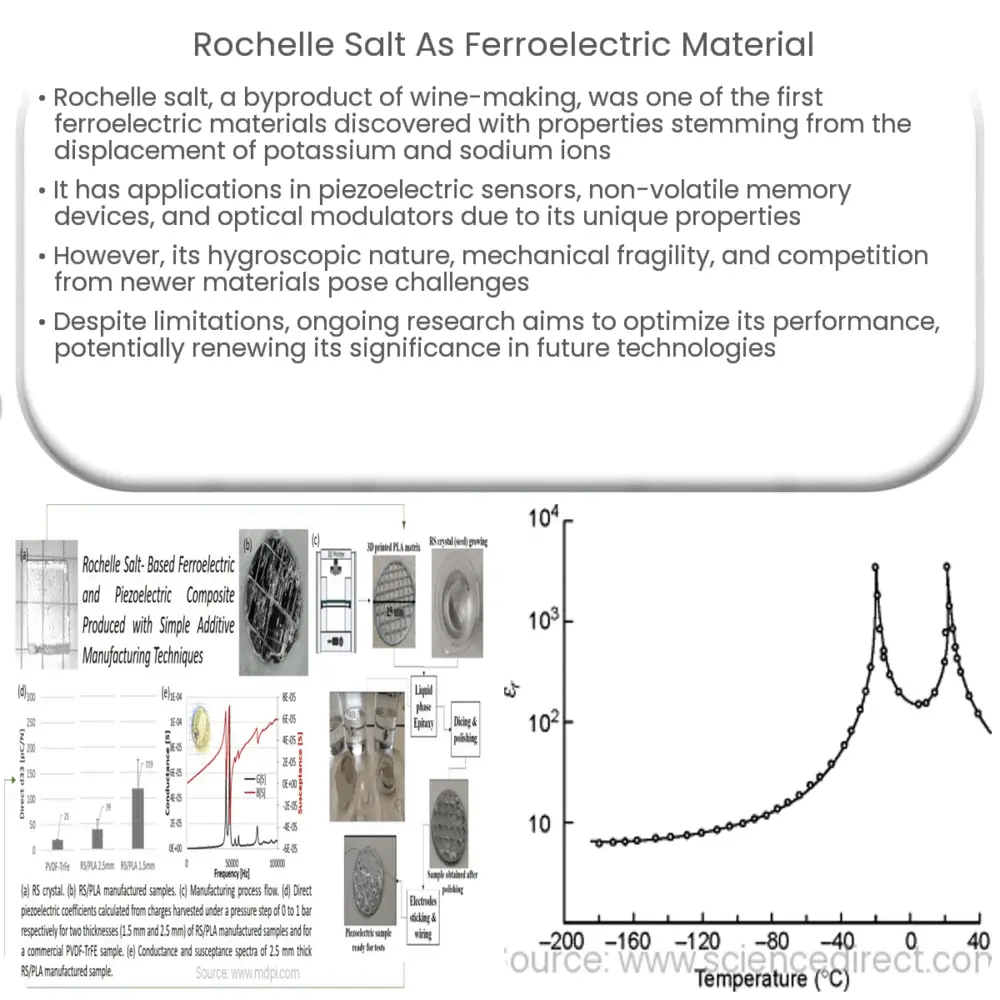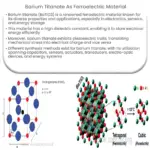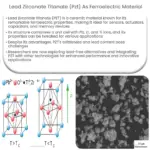Explore Rochelle salt as a ferroelectric material, its applications in modern technology, challenges, and potential for future innovations.

Rochelle Salt: A Promising Ferroelectric Material
Introduction to Ferroelectric Materials
Ferroelectric materials are a unique class of substances that exhibit spontaneous electric polarization, which can be reversed by an external electric field. This property makes ferroelectric materials ideal candidates for a variety of applications, such as capacitive sensors, non-volatile memory devices, and piezoelectric transducers. Since the discovery of the first ferroelectric material, barium titanate (BaTiO3), in the 1940s, researchers have been actively investigating new materials with enhanced ferroelectric properties to expand their applications and improve their performance.
What is Rochelle Salt?
Rochelle salt, or potassium sodium tartrate tetrahydrate (KNaC4H4O6·4H2O), is a naturally occurring crystalline substance. It was first discovered in 1675 by Pierre Seignette, a pharmacist in the French city of La Rochelle. Rochelle salt is a byproduct of the wine-making process and can be found in the sediment of certain wines. It has been used historically for various purposes, including as a food additive and a laxative. In the early 20th century, researchers discovered its ferroelectric properties, making it an important material in the study of ferroelectricity.
Rochelle Salt as a Ferroelectric Material
Rochelle salt is considered one of the first ferroelectric materials ever discovered. Its ferroelectric properties were initially observed by Valasek in 1920, who studied the piezoelectric effect in Rochelle salt crystals. The spontaneous polarization of Rochelle salt arises from the displacement of potassium and sodium ions within the crystal lattice, which is facilitated by the presence of water molecules.
One of the most significant advantages of Rochelle salt as a ferroelectric material is its high Curie temperature, the temperature at which the material loses its ferroelectric properties. For Rochelle salt, the Curie temperature lies between 18-24°C, making it suitable for applications in a broad range of temperatures.
Applications of Rochelle Salt in Modern Technology
Despite being one of the earliest ferroelectric materials discovered, Rochelle salt still holds relevance in modern technology. Its unique properties and relatively low cost make it an attractive material for research and development in various fields. Some of its applications include:
- Piezoelectric sensors: Rochelle salt exhibits a strong piezoelectric effect, which makes it suitable for use in pressure and vibration sensors, accelerometers, and microphones.
- Non-volatile memory devices: Due to its ability to retain polarization even in the absence of an external electric field, Rochelle salt can be used in non-volatile memory devices for data storage.
- Optical modulators: The electro-optic properties of Rochelle salt can be employed in optical modulators to control the amplitude, phase, or polarization of light in various optical communication systems.
Challenges and Limitations of Rochelle Salt
Despite its numerous applications, Rochelle salt is not without its limitations. Some of the challenges associated with its use as a ferroelectric material include:
- Hygroscopic nature: Rochelle salt is highly hygroscopic, which means it readily absorbs moisture from the environment. This property can lead to a loss of crystallinity and a subsequent decrease in its ferroelectric performance.
- Mechanical fragility: Rochelle salt crystals are mechanically fragile and can be easily damaged, which limits their applicability in certain environments and devices.
- Competing materials: Newer ferroelectric materials, such as barium titanate and lead zirconate titanate (PZT), have been developed with improved properties and are often preferred over Rochelle salt in modern applications.
Overcoming the Limitations and Future Prospects
Despite these challenges, researchers are continuously working on innovative solutions to overcome the limitations of Rochelle salt and enhance its ferroelectric properties. Some of these strategies include:
- Material modification: Chemical doping or substitution of certain ions in Rochelle salt can help improve its performance and stability.
- Advanced processing techniques: Developing novel synthesis and processing methods can lead to the formation of Rochelle salt crystals with enhanced properties and reduced mechanical fragility.
- Protective coatings: Applying protective coatings to Rochelle salt crystals can help mitigate the effects of moisture absorption and improve their durability.
As the field of ferroelectric materials continues to evolve, Rochelle salt remains an important material for study and potential applications. Its historical significance and unique properties make it an attractive candidate for research and development. By addressing its limitations and optimizing its performance, Rochelle salt may find renewed relevance in future technologies.
Conclusion
Rochelle salt, as one of the earliest ferroelectric materials discovered, has played a significant role in the development and understanding of ferroelectricity. Its unique properties and applications in piezoelectric sensors, non-volatile memory devices, and optical modulators demonstrate its potential as a versatile ferroelectric material. While newer materials with improved properties have emerged, ongoing research to overcome the limitations of Rochelle salt and enhance its performance may pave the way for its renewed relevance in future technologies.




